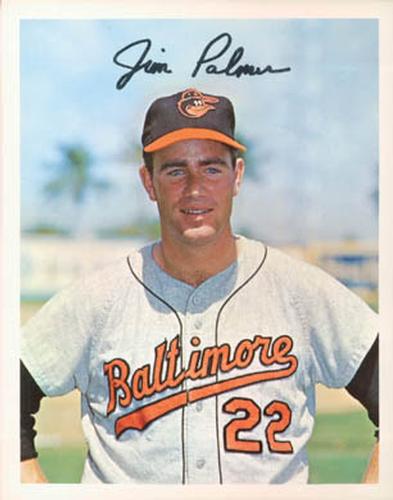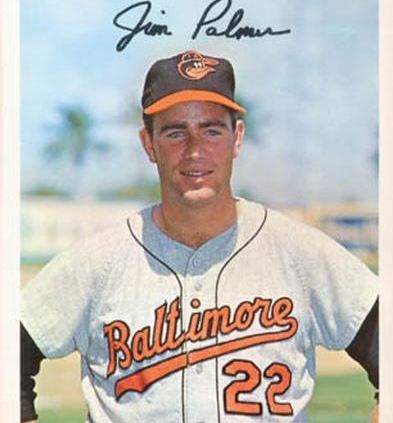Jim Palmer: The Pride of Scottsdale, Arizona
This article was written by Darren Urban
This article was published in Mining Towns to Major Leagues (SABR 29, 1999)
 The highlight of Jim Palmer’s high school baseball career was a game the star pitcher didn’t start. It was a game he didn’t win. But it was his last game in a Scottsdale High School uniform, before signing a contract soon after with the Baltimore Orioles and eventually becoming a Hall of Fame hurler.
The highlight of Jim Palmer’s high school baseball career was a game the star pitcher didn’t start. It was a game he didn’t win. But it was his last game in a Scottsdale High School uniform, before signing a contract soon after with the Baltimore Orioles and eventually becoming a Hall of Fame hurler.
The scene was this: as a prep senior in the spring of 1963, Palmer was the unquestioned superstar of the Scottsdale High Beavers. At the time, only four teams—the winners of the four high school divisions—qualified for the state tournament, meaning the Beavers needed just two victories to claim a state title. In the semifinals, Scottsdale was to play Phoenix Cortez High. Palmer, well rested, was primed to take the mound. In a season when Palmer posted a 6-1 record with 111 strikeouts and a 0.79 ERA in just 58 innings, a win was all but a lock.
For some reason, however, Scottsdale coach Boyd Hatch decided to start Tom Mooney. “I wanted to let Mooney go a few innings and save Jim for Saturday (and the championship),” Hatch told the Scottsdale Progress newspaper. “I only regret I didn’t start him.” Mooney gave up a run in the first inning and loaded the bases in the second before Palmer was brought in. It was too late, and Scottsdale lost, 3-1.
Incredibly, some at the time actually held it against Palmer, implying that the right-hander choked. But Palmer—who became one of the biggest clutch pitchers in the majors during his spectacular Orioles career—struck out 10 and gave up just one hit in the relief appearance against Cortez. Palmer was even nursing a sore arm at the time. Besides, that was only the finale of what was an amazing four years of high school athletics for Palmer.
He was a star in all three “major” sports: baseball, football and basketball. In basketball, he was a three-year starter at forward, an all-state performer, and was named the Beavers’ offensive most valuable player his senior season when he averaged 21.9 points per game. He said years later in an interview one of his biggest regrets of signing a baseball contract out of high school was missing out on a chance to play college basketball. Palmer almost didn’t play football, because no one wanted him risking his burgeoning baseball career. But Palmer and a couple friends helped hard-sell Palmer’s mother into signing the permission slip to get on the football field. In two seasons, both on varsity, Palmer was a second-team receiver on the all-state team. He could have gone on to play football in college, as well.
There was little question, however, baseball was it. Said Palmer to the Progress just before his final high school regular season game in 1963, “I want to be a major league baseball player.” It was in his blood, after going at age 9 to a Cleveland Indians-New York Yankees game at Yankee Stadium just before his family moved to Arizona. The 1954 game, Palmer claimed later in a 1998 Scottsdale Tribune article, was his “best day ever.” When Palmer got to Scottsdale, he found that Scottsdale Stadium was just about a mile away from his future high school, and he was able to watch the Boston Red Sox (who trained there at the time) and picture himself in future Cactus League games.
Then he beat one of Arizona’s top high school senior pitchers when Palmer himself was a freshman and the scouts started to take notice. So did the local paper, which had already run a photo of Palmer as a little leaguer. As a sophomore, the Progress reported Palmer’s first win of the 1961 season, after Palmer pitched the Beavers to an 8-2 victory over Phoenix Washington High. With two home runs early that season, his hitting prowess put Palmer on the list of “ones to watch for slugging.” Already 6-foot-3 and 190 pounds, Palmer ended up hitting .333 as a sophomore, .482 as a junior and .304 as a senior. He clubbed five home runs his senior season, an impressive feat in the days of shorter seasons and wooden bats.
Palmer, soon after his high school days, hit it big. Just two years after he graduated from Scottsdale High, he was pitching for the Orioles. Four years after leaving his Beaver days behind, Palmer was pitching in the World Series. But even after his 268 major-league wins, he didn’t forget his baseball roots. “What I remember most is … I would come right out of basketball and the (state) tournament and into baseball, and you’d have the high skies, and the fly balls you could never quite see,” Palmer said in a 1997 interview about playing baseball in Scottsdale.
For those who watched Palmer play baseball during those high school years, what they remember most was one of the best players—and perhaps the best athlete—the city of Scottsdale had ever produced. Even if he didn’t start against Cortez his senior year.
Darren Urban is a sports writer for the Arizona Tribune Newspapers, serving suburban Phoenix. He has written extensively about Arizona high school sports.


